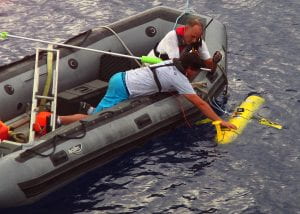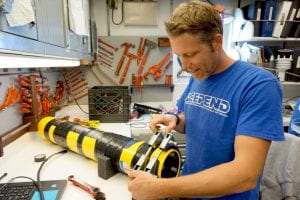Researchers Deploy New Tech to Explore
Depths Of Gulf Of Mexico
FORT LAUDERDALE/DAVIE, Fl. — A Nova Southeastern University (NSU) researcher is joining with Florida International University (FIU) marine scientist Kevin Boswell, Ph.D. and a multi-institution research team to deploy experimental technology next week in an effort to explore the deep scattering layers of the ocean.
The team is looking for information about animals in the Gulf of Mexico that make up the scattering layers — those that undergo daily vertical migrations of 100 to 1,000 meters. These animals represent the largest organized animal migration on the planet, yet little is known about them. What scientists do know is these animals are major players in the global carbon cycle, transporting carbon to deeper waters as they migrate. Some of them are part of a global discussion about whether they could have economic potential from a fisheries standpoint.
“Technology development is a critical part of exploration – every time we develop a new way to ‘see’ into the depths of the ocean, we come away with a new and important perspective, said Tracey Sutton, Ph.D., a professor and research scientist at NSU Halmos College of Natural Sciences and Oceanography. “The ability to observe the ocean autonomously is key – having several different modes of ‘eyes’ down there allows us to cover more time and space than we could from a ship.”

The research team will deploy an autonomous glider modified with sonar technology to collect up-close and personal data on the migrating animals in the water column. The slow-moving glider can stealthily travel through the water measuring where organisms are and how they are moving. The team will simultaneously deploy a prototype camera system developed by National Geographic called the Driftcam. Also an autonomous device, the Driftcam is designed to collect high-resolution images of species composition, distribution and even behavior that is not possible to capture with current technologies and methods. It too, is a minimally invasive device.
The research project is supported by the National Oceanic and Atmospheric Administration’s (NOAA) Office of Ocean Exploration and Research. Boswell leads the research team. which includes scientists from NOAA National Centers for Coastal Ocean Science, the National Geographic Society, NSU, the University of South Florida and the University of Washington.
“Our goal is to look into the deep sea without interfering,” Boswell said. “We hope to observe these animals in their natural states and collect data on their sizes, how complex their aggregations are, and learn more about their behaviors.”
Current methods include acoustic measurements from ship-based sonar and throwing nets into the water to collect specimens. Ship-based sonar is limited in its reach and detail at deeper depths. And net collections are invasive and don’t provide great insight on animal behavior including the types of groups these animals migrate with — do they stick with their own kind or do they intermingle.
Sutton said the team will be pairing advanced acoustics with free drifting cameras to study the concentrated layers of deep-sea life, and NSU’s role will be to examine the acoustics and camera images and identify the organisms to species, based on our large, previously built database on what lives in the Gulf.
“The Gulf of Mexico is a special place – one of the highest diversity deep-sea regions on the planet,” Sutton said. “We are very excited to learn more about its inhabitants.”
Traditional ship-based sonar and the experimental technologies will be combined to create a swarm of data collection in the same areas at the same time to provide a clearer picture of life in the oceans. If successful, the four-day mission will advance marine research by providing new, proven tools for seeing what lies beneath.
Boswell is a marine ecologist who specializes in acoustic technologies and has spent much of his career exploring the scattering layers in the Gulf of Mexico. The glider is designed by Teledyne Webb Research Corp. and has been outfitted with a Simrad EK80-Mini Echosounder for sonar, an acoustic device Boswell regularly uses in his research. The team’s four-day research cruise to test the technologies will launch July 28 from St. Petersburg, Fla. aboard the R/V Hogarth.
Be sure to sign up for NSU’s RSS feed so you don’t miss any of our news releases, guest editorials and other announcements. Please sign up HERE. You can also follow us on Twitter @NSUNews.
– NSU –
About Nova Southeastern University (NSU): Located in beautiful Fort Lauderdale, Florida, NSU is ranked among U.S. News & World Report’s Top 200 National Research Universities and is a dynamic, private research university providing high-quality educational and research programs at the undergraduate, graduate, and first-professional degree levels. Established in 1964, NSU now includes 16 colleges, the 215,000-square-foot Center for Collaborative Research, a private JK-12 grade school, the Mailman Segal Center for Human Development with specialists in Autism, the world-class NSU Art Museum Fort Lauderdale, and the Alvin Sherman Library, Research and Information Technology Center, which is Florida’s largest public library. NSU has campuses in Fort Lauderdale, Fort Myers, Jacksonville, Miami, Miramar, Orlando, Palm Beach, and Tampa, Florida, as well as San Juan, Puerto Rico, while maintaining a presence online globally. Classified as a research university with “high research activity” by the Carnegie Foundation for the Advancement of Teaching, NSU is one of only 50 universities nationwide to also be awarded Carnegie’s Community Engagement Classification, and is also the largest private institution in the United States that meets the U.S. Department of Education’s criteria as a Hispanic-serving Institution. Please visit www.nova.edu for more information.
About NSU’s Halmos College of Natural Sciences and Oceanography: The college provides high-quality undergraduate (bachelor’s degree) and graduate (master’s and doctoral degrees and certificates) education programs in a broad range of disciplines, including marine sciences, mathematics, biophysics, and chemistry. Researchers carry out innovative basic and applied research programs in coral reef biology, ecology, and geology; fish biology, ecology, and conservation; shark and billfish ecology; fisheries science; deep-sea organismal biology and ecology; invertebrate and vertebrate genomics, genetics, molecular ecology, and evolution; microbiology; biodiversity; observation and modeling of large-scale ocean circulation, coastal dynamics, and ocean atmosphere coupling; benthic habitat mapping; biodiversity; histology; and calcification. The college’s newest building is the state-of-the-art Guy Harvey Oceanographic Center, an 86,000-square-foot structure filled with laboratories; offices; seminar rooms; an auditorium; and indoor and outdoor running sea water facilities. Please visit cnso.nova.edu for more information.

